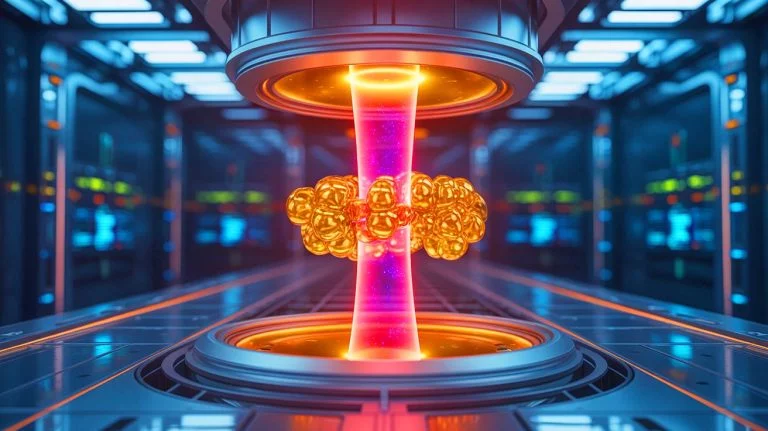| IN A NUTSHELL |
|
In a groundbreaking claim that has captured the attention of both scientists and enthusiasts of alchemical legends, Marathon Fusion, a Silicon Valley-based engineering firm, asserts it has discovered a scalable method to transform mercury into gold. This announcement, detailed in a yet-to-be-peer-reviewed paper, promises to revolutionize how we perceive nuclear fusion, potentially turning a common element into one of the most precious metals on Earth. The process, which hinges on nuclear fusion technology, could not only fuel scientific curiosity but also provide a substantial economic incentive for the development and deployment of fusion reactors.
Turning Mercury into Gold
The method proposed by Marathon Fusion involves a fascinating process where an isotope of mercury-198 is bombarded with neutrons inside a fusion reactor. This interaction transforms the isotope into mercury-197, which then decays into stable gold-197, the naturally occurring form of gold. The majority of nuclear fusion systems operate by fusing deuterium and tritium, heavier forms of hydrogen, to produce helium, high-speed neutrons, and a tremendous amount of energy.
Within this system, neutrons are typically stored in a breeding blanket, a critical component that surrounds the plasma. This setup aids in achieving tritium self-sufficiency by breeding tritium fuel from lithium. Marathon Fusion’s innovation involves introducing a bit of mercury into this breeding blanket. As the mercury-198 is converted to mercury-197, it eventually turns into gold, presenting a new frontier in fusion technology.
Making Nuclear Fusion a Lucrative Energy-Generating Activity
The implications of this discovery are staggering. According to estimates from Marathon Fusion’s founders, one gigawatt of fusion electricity could produce up to 11,023 pounds of gold annually. This amount of gold could be valued at over $550 million per year per gigawatt of fusion energy, according to a report by ZME Science. If realized, this process could nearly double the revenue of a typical nuclear fusion power plant, making fusion energy not just a cleaner alternative but an economically attractive one as well.
This approach, as outlined by the authors, could subsidize the deployment of terawatts of fusion power without market saturation, thanks to the high value of gold. The paper emphasizes that fusion is uniquely capable of producing large quantities of high-energy neutrons, essential for driving new and valuable transmutation pathways, unlike traditional fission reactions.
Innovative Fusion Blanket Design
The paper further details a proposed design for a two-layer fusion blanket composed of an “inner blanket” and an “outer blanket.” These layers are tailored to different neutron energy spectra, allowing for optimized reactions. The inner blanket is specifically designed to maximize the generation of gold, utilizing the fast 14 MeV neutrons from the deuterium-tritium fusion plasma to enable the desired reaction pathways at scale.
This innovative approach does not negatively impact electricity production and aligns with the demanding tritium breeding requirements of fusion power plant design. As such, it represents a significant leap forward in making fusion energy economically viable, offering a dual benefit of clean energy and valuable byproduct in gold.
The Bigger Picture of Chrysopoeia
The concept of transforming base metals into gold, historically known as chrysopoeia, has been a subject of fascination and pursuit for centuries. While small-scale demonstrations have occurred using particle accelerators, none have proven economically viable until now. Marathon Fusion’s scalable method of synthesizing stable gold from mercury via (n, 2n) reactions in a specialized neutron multiplier layer of a fusion blanket could change this narrative.
By implementing this concept, fusion power plants could potentially double their revenue, enhancing the economic feasibility of fusion energy and pushing the boundaries of what is possible in nuclear science. This breakthrough raises intriguing possibilities for the future of both energy production and material science, blending ancient dreams with cutting-edge technology.
As we stand on the brink of potentially realizing the age-old dream of alchemists, the question remains: how might this new capability transform not just the energy sector, but the global economy and our understanding of elemental science?
Did you like it? 4.5/5 (24)








Is this the modern-day Philosopher’s Stone? 🤔
Wow, turning mercury into gold? What’s next, lead into platinum? 😂
How do they ensure the process is safe and doesn’t release harmful toxins? 🌍
Nope… if it were that easy the price of Gold would crash.
Seems too good to be true. Has any independent lab verified their claims?
Thank you for sharing this intriguing breakthrough! Can’t wait to see how it develops. 😊
What are the environmental impacts of this process? Can they be mitigated?
Alchemists of the past would be proud! 👏
Seems like a plot from a sci-fi novel. Are we sure this isn’t fiction? 📚
Can this technology be adapted for other elements?